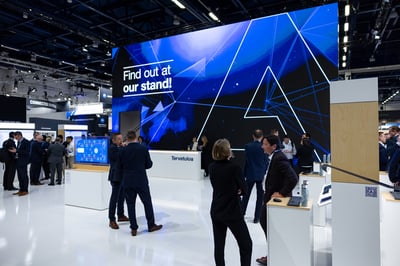Do you find your radios difficult to use? Ever have the signal drop out, cutting you off from dispatchers? Read on to discover how TETRA radios can solve these challenges as well as others that users and the network may face.
Challenge 1 – “It’s so hard”
People working in the field need easy-to-use tools. The easier it is to communicate, the more they will trust the service and so can concentrate on their critical tasks.
Solution: When the radio is easy to use, communication is also easier.
Here’s an example. When a dispatcher sends a new talk group to a person’s radio, he can also choose to set it as the selected group on that radio. This way, the radio user is instantly part of the communication in that group, with no need to select the group manually. So much easier!
Another example is the secondary PTT. The user can quickly and easily talk to two different groups without fiddling with the group selector. Pressing the primary PTT, connects to one group and pressing the secondary PTT above it, lets the user speak to another – the nearest dispatcher, for example.

Challenge 2 – Breaks in communication
Officers in the field need to move around, but it’s annoying when audio drops out because the user has moved from one base station area to another.
Solution: Faster handovers
Communications do not have to break when moving from cell to cell.
When the system and radio both use Type 1 Handover – a mechanism in TETRA – connections continue unbroken. Without Type 1 Handover, radios need to register with each new cell and thus become unavailable for between half a second and one and a half seconds every time they hand over.
Radios with Type 1 Handover synchronise themselves with a new base station as soon as it is detected, so they are ready to communicate as soon as the switch from cell to cell takes place. Instant handover means better audio when on the move
Challenge 3 – “What’s your position?”
Dispatchers in control rooms need to be fully aware of the situation their field officers are in, but asking them over the audio channel can be slow and not always effective or convenient.
Solution: Better awareness of team locations
To maximize the dispatcher’s situational awareness, the TETRA system and radios use short data messages to transfer location information. The dispatcher can also send trigger messages and command the radio to update its location information. This is faster than asking for people’s position by voice. It requires only minimal system resources, but the benefits are great.
Field managers can also get their own team members' positions with the “Where are you” function. In "Where are you," radios also share their position info when they are transmitting. The field manager will see on his radio display an arrow pointing to the direction of the person speaking, and the distance. "Where are you" works also in Direct Mode.
Challenge 4 – Traffic overload
When a situation is tight, there is usually a lot of traffic in the radio network. How can we avoid traffic overload?
Solution: Better balance
Some networks can achieve a better balance and distribute radios to use base stations more cleverly. This is possible with a mechanism called load-directed roaming. With load-directed roaming in both the system and radio, the radio can avoid cells with high traffic loads, opting instead to use less heavily loaded cells nearby, even if it has lower field strength. These radios can get a connection while other radios are put into a queue.
This makes things better for users as important communications can get through.

The network owner and operator also benefit. Fewer base station sites can support a larger number of users because the load between the base stations is shared.
Challenge 5 – Divided attention
First responders often have a critical task which needs their focus – and they need to operate the radio at the same time.
Solution: Using the radio without looking
Voice feedback means that the radio speaks out the action that the user is taking. For example, the radio will say out loud:
- Which group the user just selected
- Which mode the user switched to – Direct Mode (DMO) or normal network mode
- Which action on the Fast Menu the user chose.
What’s more, the radio will speak the language that is selected for the display and menu texts.
Thanks to voice feedback, it is easy to use the radio without looking at it. The user can focus on the task at hand rather than on operating the radio.

Make sure you get a radio that helps you avoid the five challenges! Learn to write your radio RFP/RFQ so you get what you really need - Download this eBook:





